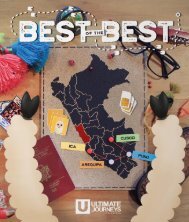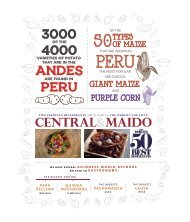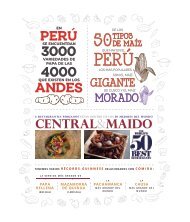UJ #17 - Traditional Peru
You also want an ePaper? Increase the reach of your titles
YUMPU automatically turns print PDFs into web optimized ePapers that Google loves.
MAY | PILGRIMAGE TO THE SANCTUARY OF<br />
THE LORD OF QOYLLORITI<br />
Diego Oliver<br />
<strong>Peru</strong> is known for both its natural and cultural wealth.<br />
The traditions and festivities that we celebrate today<br />
are the culmination of many different customs from all<br />
over the country, some native and others brought in by<br />
View of the<br />
sanctuary of the<br />
Señor de Qoylloriti<br />
amongst the<br />
mountains. The<br />
pilgrims camp<br />
in the nearby<br />
surrounding areas.<br />
immigrants and slaves who looked to maintain ties with<br />
their own, personal stories.<br />
Local syncretism can be seen in religious traditions<br />
that bring together Andean beliefs with those that<br />
were imported and imposed by the Spanish. Looking to<br />
eradicate idolism and to evangelize the natives, Spanish<br />
conquistadors and priests forebade “pagan” celebrations<br />
upon their arrival. Nonetheless, locals managed to adapt<br />
their beliefs, replacing deities and gods of nature with<br />
the religious characters brought from Europe. Their<br />
worship continued disguised under a different name.<br />
Each ‘nation’<br />
shares its<br />
traditional<br />
dances.<br />
The celebration of the Lord of Qoylloriti in Cusco is a clear<br />
example of this union between the original native beliefs,<br />
with those later imposed and eventually adopted. What<br />
was originally done in honour of fertility in pre-Hispanic<br />
times is now considered one of the most feverous<br />
religious pilgrimages in the country, as over 10 thousand<br />
people hike up the sacred Ausangate Mountain carrying<br />
Diego Oliver<br />
crosses and dressed in extravagant, colourful outfits.<br />
The legend of its origin dates back to 1780, when the<br />
government decided to ‘christianize’ the ritual in attempts<br />
to neutralize the indigenous revolutionary uprising. It was<br />
then that the story of Marianito was born. Marianito was<br />
a young boy, son of local peasants, who was herding his<br />
sheeps near Sinakara when a mysterious, light-skinned<br />
boy appeared, to whom Marianito offered food and<br />
shelter. One day, this strange boy re-appeared with<br />
tattered clothing. Marianito, wanting to help, offered to go<br />
to Cusco and search for a similar cloth in order to repair<br />
the broken clothes. Upon arriving and inquiring about<br />
The grand<br />
procession<br />
to the foot<br />
of the Apus.<br />
Diego Oliver<br />
Corn, fruit, and<br />
bread are some of<br />
the offerings made<br />
during ceremonies.<br />
An example of<br />
Andean syncretism.<br />
IN 2004, THE CELEBRATION AND THE<br />
SANCTUARY WERE DECLARED NATIONAL<br />
CULTURAL HERITAGE OF PERU. THEN, IN<br />
2011, UNESCO NAMED IT AN INTANGIBLE<br />
CULTURAL HERITAGE.<br />
36<br />
Diego Oliver

















